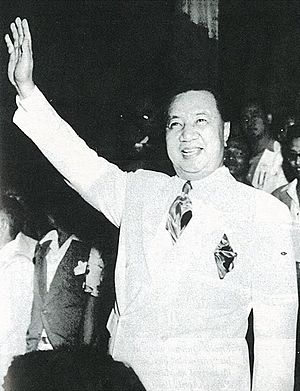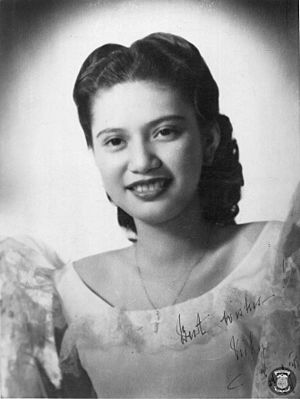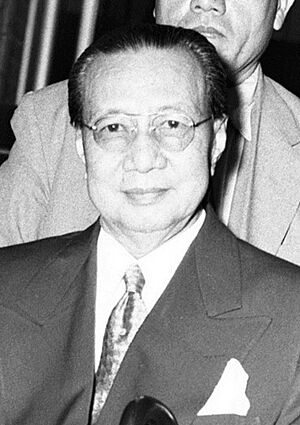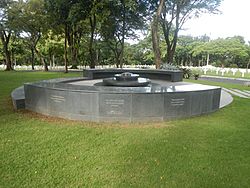Elpidio Quirino facts for kids
Quick facts for kids
Elpidio Quirino
|
|
|---|---|
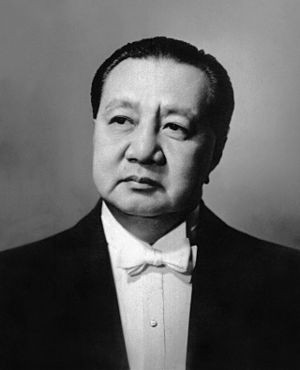 |
|
| 6th President of the Philippines | |
| In office April 17, 1948 – December 30, 1953 |
|
| Vice President | Ramon Avanceña (1948–1949 de facto) Fernando Lopez (1949–1953) |
| Preceded by | Manuel Roxas |
| Succeeded by | Ramon Magsaysay |
| 2nd Vice President of the Philippines | |
| In office May 28, 1946 – April 17, 1948 |
|
| President | Manuel Roxas |
| Preceded by | Sergio Osmeña |
| Succeeded by | Fernando Lopez |
| Secretary of Foreign Affairs | |
| In office September 16, 1946 – January 6, 1950 |
|
| President | Manuel Roxas Himself |
| Preceded by | Felipe Buencamino (as Secretary of Foreign Relations) |
| Succeeded by | Felino Neri |
| Secretary of Finance | |
| In office May 28, 1946 – November 24, 1946 |
|
| President | Manuel Roxas |
| Preceded by | Jaime Hernandez |
| Succeeded by | Miguel Cuaderno |
| In office July 25, 1934 – February 18, 1936 |
|
| President | Manuel L. Quezon |
| Preceded by | Vicente Encarnación |
| Succeeded by | Antonio de las Alas |
| Secretary of the Interior | |
| In office 1935–1938 |
|
| President | Manuel L. Quezon |
| Preceded by | Severino de las Alas |
| Succeeded by | Rafael Alunan |
| 4th President pro tempore of the Senate of the Philippines | |
| In office July 9, 1945 – May 25, 1946 |
|
| President | Sergio Osmeña |
| Preceded by | José Avelino (acting) |
| Succeeded by | Melecio Arranz |
| Senator of the Philippines | |
| In office July 9, 1945 – May 28, 1946 |
|
| In office 1925 – November 15, 1935 Serving with Isabelo de los Reyes (1925–1928)
Melecio Arranz (1928–1935) |
|
| Preceded by | Santiago Fonacier |
| Succeeded by | Position abolished |
| Constituency | 1st district |
| Member of the Philippine House of Representatives from Ilocos Sur's 1st district | |
| In office 1919–1925 |
|
| Preceded by | Alberto Reyes |
| Succeeded by | Vicente Singson Pablo |
| Personal details | |
| Born |
Elpidio Quirino y Rivera
November 16, 1890 Vigan, Ilocos Sur, Captaincy General of the Philippines |
| Died | February 29, 1956 (aged 65) Quezon City, Philippines |
| Resting place | Manila South Cemetery, Makati, Metro Manila, Philippines (1956–2016) Libingan ng Bayani, Taguig, Metro Manila, Philippines (since February 29, 2016) |
| Political party | Liberal (1945–1956) |
| Other political affiliations |
Nacionalista (before 1945) |
| Spouse |
Alicia Syquia
(m. 1921; |
| Relations | Cory Quirino (granddaughter) Monique Lagdameo (great-granddaughter) |
| Children | 5, including Victoria Quirino González |
| Alma mater | University of the Philippines (LL.B) |
| Profession | Lawyer |
| Signature | |
Elpidio Quirino y Rivera (November 16, 1890 – February 29, 1956) was a Filipino lawyer and politician. He served as the sixth president of the Philippines from 1948 to 1953.
Quirino started his political journey as a representative for Ilocos Sur from 1919 to 1925. Later, he became a senator from 1925 to 1935. In 1934, he helped secure the Tydings–McDuffie Act in the United States Congress. This act set the stage for Philippine independence. He also helped draft the 1935 Constitution of the Philippines. Under President Manuel L. Quezon, he served as a government secretary.
After World War II, Quirino was elected vice president in 1946. When President Manuel Roxas passed away in April 1948, Quirino became president. He then won a full term as president, representing the Liberal Party.
During his time as president, Quirino faced challenges from the HukBaLaHap group. He ran for president again in 1953 but lost to Ramon Magsaysay.
Early Life and Education
Elpidio Quirino was born on November 16, 1890, in Vigan, Ilocos Sur. He was the third child of Mariano Quirino and Gregoria Rivera. Young Elpidio spent his early years in Aringay, La Union. He finished elementary school in Caoayan, where he even worked as a barrio teacher.
He went to Vigan High School and then Manila High School, graduating in 1911. He also passed a civil service exam. Quirino studied law at the University of the Philippines in Manila. He earned his law degree in 1915 and became a lawyer.
His daughter, Victoria, became the youngest official hostess of Malacañang Palace when her father became president. She was only 16 years old.
His Time in Congress
Serving in the House of Representatives
Before becoming president, Quirino worked as a private lawyer. He was then elected to the House of Representatives of the Philippines from 1919 to 1925.
Becoming a Senator
In 1925, Quirino was elected as a senator for the First Senatorial District. He served until 1935. During this time, he also worked as the secretary of finance and interior for the Philippine Commonwealth.
In 1934, Quirino was part of a group sent to Washington, D.C.. This group, led by Manuel L. Quezon, helped pass the Tydings–McDuffie Act. This law set the date for the Philippines to become independent in 1945. The country officially gained independence on July 4, 1946.
After World War II, the Philippine government was restored. Quirino was re-elected to the Senate and became the Senate President pro tempore.
Becoming Vice President
After the government was restored in 1945, Senator Manuel Roxas, Quirino, and their allies pushed for an early national election. This election would choose the president, vice president, and members of Congress. The election was set for April 23, 1946.
Quirino was chosen as Manuel Roxas's running mate for vice president. They won the election. As Vice President, Quirino was also appointed as the Secretary of Foreign Affairs.
Leading the Nation: His Presidency
| Presidential styles of Elpidio Quirino |
|
|---|---|
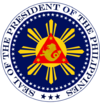 |
|
| Reference style | His Excellency |
| Spoken style | Your Excellency |
| Alternative style | Mr. President |
Quirino's five years as president focused on rebuilding the nation after the war. The country saw economic growth and received more help from the United States.
First Term (1948–1949)
Becoming President
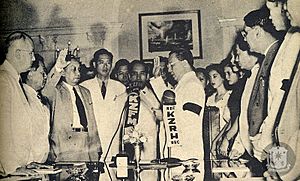
Quirino became president on April 17, 1948, just two days after President Manuel Roxas passed away. His first act was to declare a period of national mourning for Roxas. Since Quirino was a widower, his daughter, Victoria, became the official hostess of the palace.
New Capital City
On July 17, 1948, a law was passed that declared Quezon City as the new capital of the Philippines. It replaced Manila. However, Manila remained the working capital until government offices officially moved.
Dealing with the Hukbalahap
The Hukbalahap, or "Huks," were a group that caused problems in towns and villages. The government tried to make peace with them, but the agreement failed. President Quirino then ordered a stronger campaign against the Huks.
Fireside Chats
To connect with the people, President Quirino brought back "fireside chats." These were regular radio broadcasts from Malacañang Palace where he explained what the government was doing.
Impeachment Attempt
Some people tried to remove President Quirino from office. They accused him of various issues, including favoring family members. A committee in the House of Representatives looked into these charges. After many hearings, the committee cleared the President of all accusations on April 19, 1949.
UN General Assembly President
In September 1949, Carlos P. Romulo, a Filipino delegate, was elected as the President of the United Nations General Assembly. He was the first person from Asia to hold this important position.
1949 Presidential Election
President Quirino won a full term in the November 1949 presidential election. His running mate, Fernando Lopez, became Vice President. This election was criticized for having problems with fairness and violence.
Second Term (1949–1953)

Asian Conference
In May 1950, President Quirino hosted a meeting in Baguio with representatives from several Asian countries like India, Pakistan, Ceylon, Thailand, Indonesia, and Australia. They discussed economic and cultural issues. This meeting showed the start of possible future cooperation among these nations.
Continued Huk Challenges
The Quirino government continued to face a serious threat from the communist Hukbalahap movement. The Huks were originally an anti-Japanese group, but communists took over their leadership. When talks with Huk leader Luis Taruc failed in 1948, Taruc openly declared himself a Communist.
Peace Efforts
The government continued its efforts to improve peace and order. They started a land resettlement program for Huks who surrendered. This program, called the Economic Development Corps (EDCOR), helped former Huks start new lives. Most of them stayed in these new settlements.
The Armed Forces of the Philippines were also reorganized. New army units like the Scout Rangers were created. These units showed great skill and bravery.
1951 Midterm Election
After the Liberal Party won many seats in 1949, many Filipinos doubted the election results. This led to the Nacionalistas winning almost all seats in the 1951 elections. The Liberal Party did not win any Senate seats.
1953 Presidential Election
Quirino ran for re-election in 1953, even though he was not in good health. However, his Secretary of National Defense, Ramon Magsaysay, left his party and joined the Nacionalista Party. Other important Liberals also left Quirino's party.
On Election Day, Quirino was defeated by Magsaysay by a large number of votes.
Domestic Policies
Economy
When Quirino became president, he focused on two main goals: rebuilding the nation's economy and restoring people's trust in the government. He created several groups to help with these goals. For example, the President's Action Committee on Social Amelioration (PACSA) helped families in need. The Agricultural Credit Cooperatives Financing Administration (ACCFA) helped farmers.
Social Programs
President Quirino worked to improve the lives of ordinary people. He visited poor areas and then announced a seven-point plan for social security. This plan included ideas for unemployment insurance, old-age insurance, and health insurance. He also created the Social Security Commission to help less fortunate citizens.
Land Reform
To help farmers, President Quirino created the Land Settlement Development Corporation (LASEDECO) in 1950. This group was responsible for settling people on new lands.
Integrity Board
To fight unfair practices in government, President Quirino created the Integrity Board. This board investigated reports of corruption in high government positions.
Foreign Policies
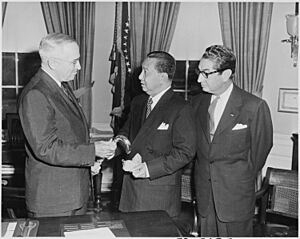
Quirino's government was very good at diplomacy. He impressed leaders from other countries with his intelligence. He traveled to the United States, Europe, and Southeast Asia, representing the Philippines well. During his time in office, he signed treaties and agreements with other nations. Two Asian leaders visited the Philippines: President Chiang Kai-shek of China in 1949 and President Sukarno of Indonesia in 1951.
In 1950, when the Korean War began, President Quirino sent over 7,450 Filipino soldiers to Korea. These soldiers were known as the Philippine Expeditionary Forces to Korea (PEFTOK).
While I recognise the United States as a great builder in this country, I have never surrendered the sovereignty, much less the dignity and future of our country.
—Elpidio Quirino
In 1951, the Philippines signed the Mutual Defense Treaty with the United States. This agreement aimed to protect against the threat of communism during the Cold War. This military alliance is still important today.
Korean War
When North Korea attacked South Korea in June 1950, the United Nations quickly responded. Carlos P. Romulo became a strong voice for South Korea. The Philippines offered to send soldiers to help, becoming the first country to join the United States in offering military aid.
President Quirino made sure the Philippine offer was carried out. The first group of soldiers, the Tenth Battalion Combat Team, was sent to Korea. They became known for their military skill and bravery. Other Filipino combat teams followed, earning a reputation for discipline and courage.
Quirino-Foster Agreement
In 1950, an American group called the Bell Mission studied the Philippines' economy. They made several suggestions for improvement. President Quirino agreed to these recommendations. In November 1950, he signed an agreement with William Chapman Foster from the United States government. Quirino promised to pass laws based on the report, and Foster promised the necessary aid.
Despite his efforts, Quirino faced challenges that made his administration unpopular. These included:
- The government's difficulty in stopping the Huk threat, which made travel in some provinces unsafe. For example, former First Lady Aurora Quezon was killed by Huks in 1949.
- Economic difficulties, such as rising unemployment and high prices for goods.
Life After the Presidency
After losing the election, Quirino retired from public office. He continued to serve the Filipino people by becoming known as the "Father of Foreign Service" in the Philippines.
Elpidio Quirino passed away on February 29, 1956, at his home in Novaliches, Quezon City. He was 65 years old and suffered a heart attack. His remains were first buried at the Manila South Cemetery. On February 29, 2016, his remains were moved to a special tomb at the Libingan ng mga Bayani in Taguig.
Personal Life
Quirino married Alicia Syquía in 1921. They had five children. Sadly, on February 9, 1945, his wife and three of their children were killed by Japanese troops during the Battle of Manila.
In a show of forgiveness, Quirino later granted amnesty to all Japanese war criminals and Filipino people who had worked with the Japanese during the war. They were released by December 1953.
Memorials
Many places are named after Elpidio Quirino. The province of Quirino, created in 1966, is named in his honor. Quirino Avenue in Manila and the LRT station there are also named after him. The Novaliches-Ipo Road is now called Quirino Highway. There is also a Quirino Grandstand in Manila's Rizal Park.
In 2016, a memorial for him was built in Hibiya Park, Tokyo, Japan.
Images for kids
See also
 In Spanish: Elpidio Quirino para niños
In Spanish: Elpidio Quirino para niños


